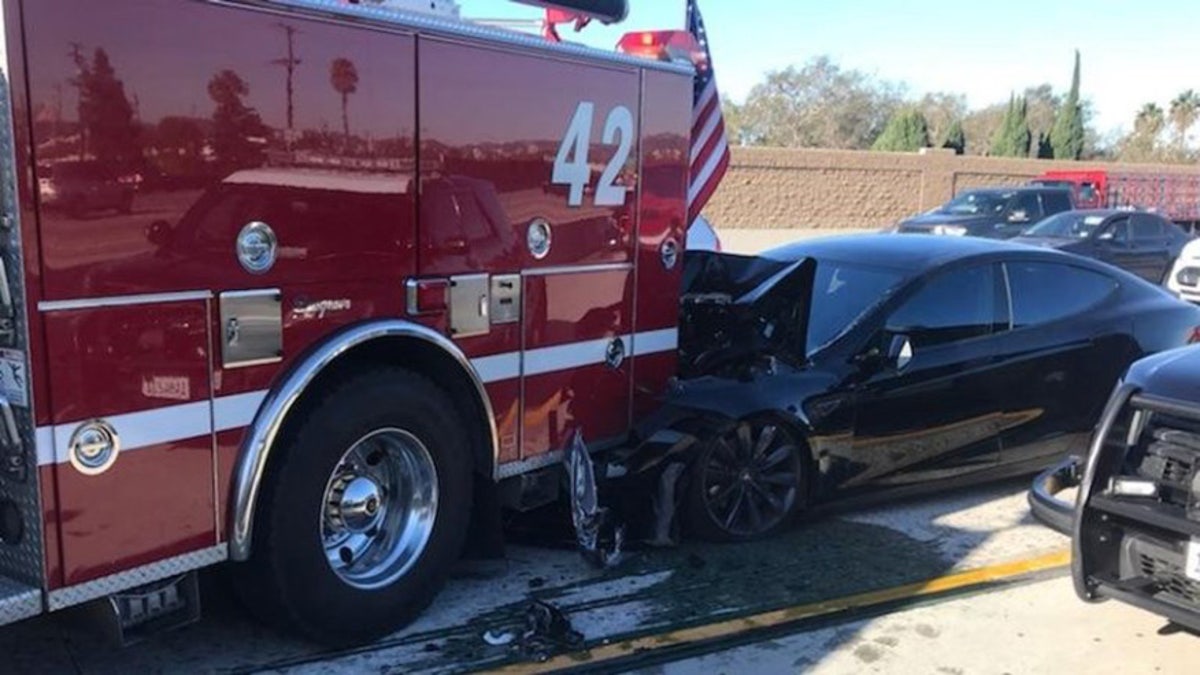
A Tesla rear-ended a fire truck parked to respond to an accident on I-405 in Culver City, Calif. on Jan. 22, 2018, according to the Culver City Fire Department and California Highway Patrol. (Culver City Firefighters Local 1927) (Culver City Firefighters Local 1927)
The U.S. government has sent two investigators to collect evidence from an an accident involving a Tesla Model S that was allegedy operating in its 'Autopilot' mode when it crashed into the back of a parked fire truck on Monday in Culver City, California.
The National Transportation Safety Board said on twitter that the team will be focusing on driver and vehicle factors.
The accident took place in broad daylight on Interstate 405 when the Tesla rear-ended the fire truck, which was responding to a previous incident. Witnesses estimate that the car was traveling at 65 mph at the time of the collision and that the driver said Autopilot was activated.
This is the second time the NTSB has looked into a crash involving Tesla's Autopilot feature, which is a driver assist system with limited semi-autonomous capabilities.
The NTSB in September determined that design limitations of the Tesla Model S Autopilot played a major role in a May 2016 fatal crash in Florida involving a vehicle operating under Autopilot. But it blamed the crash on an inattentive Tesla driver's overreliance on technology and a truck driver who made a left turn in front of the car.
The California investigation comes as Congress and federal agencies grapple with how to regulate autonomous vehicles and those with systems that are partially self-driving. The systems can significantly reduce crashes, but computer-driven vehicles also can make mistakes.
Tesla wouldn't say if Autopilot was working at the time of the Culver City crash, but said in a statement Monday that drivers must stay attentive when it's in use. The company would not comment on the investigation.
In Monday's crash, the California Highway Patrol and the Culver City Fire Department confirmed the southbound Tesla hit the rear of the firetruck but could not confirm if Autopilot was operating, The Mercury News of San Jose reported.
The firetruck was parked in the left emergency and carpool lane with emergency lights flashing to block a previous crash on Monday morning, Culver City Fire Battalion Chief Ken Powell told the newspaper. The Tesla suffered significant damage, but the driver showed no significant injuries, Powell said.
The Model S Autopilot is a level 2 on a self-driving scale of 0 to 5. Level 5 vehicles can operate autonomously in nearly all circumstances. Level 2 automation systems are generally limited to use on interstate highways, which don't have intersections. Autopilot keeps a vehicle centered in its lane at a set distance from cars in front of it. It also can change lanes and brake automatically. Drivers are supposed to continuously monitor vehicle performance and be ready to take control if necessary.
In the Florida crash, which killed an Ohio man driving the Tesla, NTSB investigators found that the sedan's cameras and radar weren't capable of detecting a vehicle turning into its path. Rather, the systems are designed to detect vehicles being followed to prevent rear-end collisions. The NTSB re-issued previous recommendations that the government require all new cars and trucks to be equipped with technology that wirelessly transmits the vehicles' location, speed, heading and other information to other vehicles in order to prevent collisions.

(Joshua Brown was killed in Florida in 2016 when he and his Tesla's Autopilot failed to detect a tractor trailer crossing the road in front of it.)
The NTSB also recommended that automakers develop systems to make sure drivers pay attention while using semi-autonomous systems, other than detecting the pressure of hands on the steering wheel. The driver in the Florida crash had his hands on the sedan's steering wheel for only 25 seconds out of the 37.5 minutes the vehicle's cruise control and lane-keeping systems were in use prior to the crash, investigators found.
Tesla has taken steps to prevent drivers from using Autopilot improperly, including measuring the amount of torque applied to the steering wheel and sending visual and audio warnings. If the warnings are ignored, drivers would be prevented from using Autopilot, the company has said.
The National Highway Traffic Safety Administration, which regulates auto safety, declined last year to issue a recall or fine Tesla as a result of the crash, but it warned automakers they aren't to treat semi-autonomous cars as if they were fully self-driving.
The Associated Press contributed to this report



















